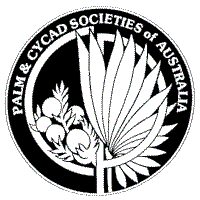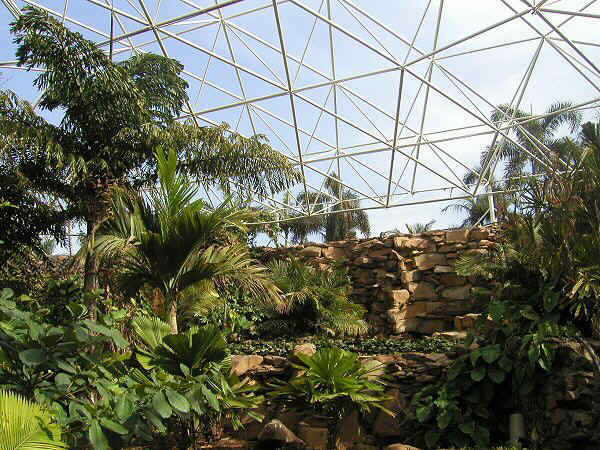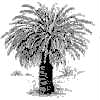|
Places
The Jardin Botanico del Palmetum de Santa Cruz |

| |||
|
| ||||
|
(The original Spanish version of these pages can be found here)
Part I - Introduction and Description
The Palmetum of Santa Cruz de Tenerife is an unfinished botanical garden of 120.000 m2 specialized in palms (Arecaceae) and divided in biogeographical sections. It is the largest green space in the centre of Santa Cruz de Tenerife, the capital of the Western Canary Islands. It was created above an artificial hill between the city and the ocean: a former landfill of urban garbage which was closed 1983.
The project was started in 1995 with funding from the European Union and the city of Santa Cruz. The hill was landscaped under the direction of the agronomists Manuel Caballero and Jose Timon, the biologist Carlo Morici and the garden designer Carlos Simon. The park includes a large system of waterfalls, streams and ponds, an unfinished Ethnographical Palm Museum dedicated to palms with >1,000 ethnographical pieces, with offices and labs and a shadehouse called the octagon for the most tender species. The collection grew conspicuously during the years of intense cooperation with other botanic gardens, in 1996-1999, but at the end of 1999 the incomplete project was paralysed as it run out of funding. The garden has never been opened to the public. From 2000 to 2007 the gardens had highs and lows, with some years or months of near-abandonment that reduced the palm species in cultivation from about 460 in 1999 to 296. The friends of the Palmetum struggled for years to keep the valuable collection alive through the worst times. In 2007 a new wave of interest and a larger flow of money allowed us to work on the project again. The government of the Canary Islands funded some major works and we improved the overall state of the park and landscaped the Southern slopes of the hill, which had never been planted on before. The garden now keeps about 800 plant species and has a total number of approximately 2.600 specimens. About 300 palm species constitute a reference palm collection with many valuable uncommon species. 72 of the represented taxa are endangered species included in the IUCN red list. The collection focuses on palms from islands, with the biogeographical section dedicated to the Caribbean being the largest, spreading over an area of 50.000 m2. The collection of the Caribbean palm genera Thrinax, Coccothrinax and Hemithrinax are among the most complete in the world. A brighter future will come in the next years, because a public foundation was created in June 2007 to manage the future of the Palmetum. The full name is Fundacion Canaria del Jardin Botanico del Palmetum de Santa Cruz. It will be controlled by some of the most important political institutions, and also the local University of La Laguna.
Location and Climate
The climate of the Canary Island is Subtropical Oceanic, with a Mediterranean rainfall pattern. The Average Annual Temperature of Santa Cruz is 21 C (70 F), with the Average Yearly Rainfall being 230 mm (9 inches), falling mainly in winter. The minimum winter temperature is usually about 15 C (59 F). The oceanic climate is extremely even, so cold or hot fronts from the mainland hit the island are weakened by the effect of the sea. Winds are frequent, mostly from the NE, especially in summer, and the short rainy season lasts a few months in winter. Strong windstorms happen every few years, with the most intense wind speeds reaching maximums of about 110 km/h (January 1999) and 147 km/h (November 2005). Hail fell in January 1999.
Project Scope and Goals
Criteria for Landscape Design
There is a great system of cascades, rivers, and lakes, decorated with natural rocks, separating the distinctly themed areas. A crown of mixed trees surrounds the edge of the plateau, blocking the wind and creating an even more favourable environment for the trees inside as they begin to grow larger. The technicians responsible for the design of the landscape were Carlos Simon, who designed several waterfalls that were built with immense natural rocks, and also Carlo Morici, author of the present report. Carlos Simon designed the sections dedicated to Madagascar, the Mascarene Islands, Australia, South America, Africa, part of Caribbean, Indochina, and the Octagon (A shade house for the palms). Carlo Morici designed the Hawaiian sections, Melanesia, New Caledonia, New Guinea, Borneo, Canary Islands, part of the Carribbean, Indochina, and the majority of the slopes. Elias del Castillo, fellow worker of the late Cesar Manrique, co-directed the design of the large cascade of carbonated rock dominating the Caribbean section.
Criteria for the Selection of Species
| |||||||||||||||||








